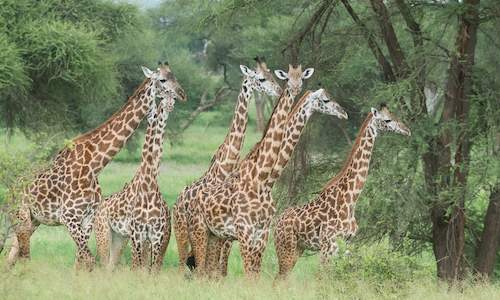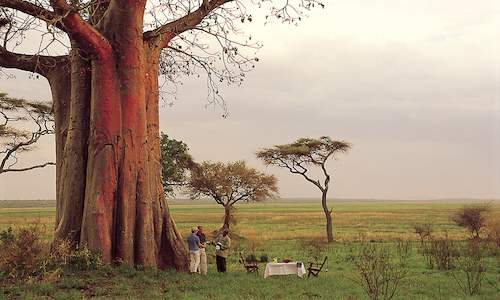
Access
The easiest access is via road and this is how Tarangire is included in many northern circuit tours. It is an easy drive from Arusha and Lake Manyara and is close to the Ngorongoro Crater and the Serengeti.Airport
There are several bush airstrips in or near the park and you can catch chartered flights from Arusha and the Serengeti.Regions
The Tarangire River flows through the northern regions of the park. This perennial river is what draws vast concentrations of wildlife during the dry winter months. The southern area of the park has a series of swamps which turn into dry plains for most of the year. The park is also known for its many thick Baobab trees.Tarangire's vegetation consists of dry, open woodlands, which include acacia thickets, acacia tortillis trees and the occasional palm tree. The flat swamps in the southern regions of the Park are impassable during the rains.
Highlights
- Enjoy discovering the smaller critters of the African bush while on guided walking safaris
- Set out on an expedition to see ancient bushmen rock art
- Largest concentration of wildlife outside the Serengeti in Tanzania
Tarangire Activities

Walking safaris
These are a wonderful way to really experience life in the bush and see the regions many herbivores and perhaps a couple of predators too! You will be accompanied by your guide and an armed National Parks Ranger.Game drives
This region gets less rainfall than the rest of Tanzania and is semi arid. It is dominated by Acacia tress and Baobabs. This makes game viewing easy. Visitors staying in one of the camps or a nearby lodge can enjoy game drives in the park. These game drives are a great way to cover a large area and spot many of the regions larger animals.Climate
During the dry season (June to October), Tarangire competes with Ngorongoro Crater when it comes to wildlife concentrations. Many migratory animals are found at the permanent waters of the Tarangire River. Huge herds of Wildebeest, Zebras, Buffalo, Elephants, Impala, Giraffe, Eland and Oryx will stay in Tarangire until the onset of the rains when they migrate again to other good grazing areas.The Tarangire Experience

A comfortable drive from Arusha makes Tarangire an easy safari stop for guests travelling the northern circuit to Ngorongoro or Serengeti. However, most Tanzania safari travellers push on and this leaves Tarangire a best-kept secret on the northern safari circuit. Tarangire is a year-round park with distinct seasons offering different experiences. The dry season sees a multitude of wildlife around the river and the green season is full of new-born animals
The Ancient Vistas of Tarangire
The vast number of baobabs seen when entering Tarangire National Park signifies an ancient place, an Africa of the past. The park is dotted with these majestic trees and provides for picture postcard photographs - especially when Elephants, of which there are numerous in Tarangire, are feeding beneath the trees. In fact Baobabs and Elephants typify the soul of the park.
Tarangire National Park has one of the highest densities of Elephant anywhere in Tanzania. Lion and Leopard are common throughout Tarangire, whilst Cheetah are often seen in the open areas of the south. Spotted Hyenas are regularly seen, but sightings of Wild dog are rare.
Over 500 species of birds have been recorded in Tarangire, with screeching flocks of the colourful yellow-collared lovebird, the rufous-tailed weaver and ashy starling, all of which are endemic to Tanzania.

 Tarangire National Park is located in the Manyara Region of Tanzania, and is the sixth largest park in the country....
Tarangire National Park is located in the Manyara Region of Tanzania, and is the sixth largest park in the country.... Part of the legendary northern safari circuit of Tanzania, Tarangire is nonetheless a stand-alone safari destination that moves to its own u...
Part of the legendary northern safari circuit of Tanzania, Tarangire is nonetheless a stand-alone safari destination that moves to its own u...